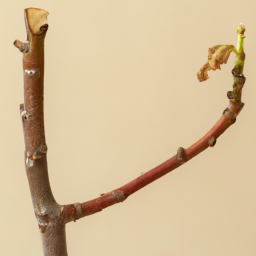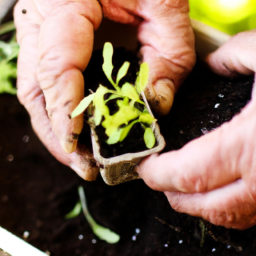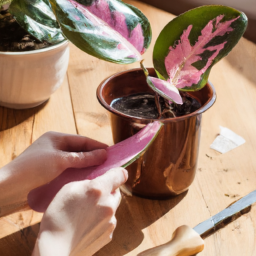
Have you ever wondered how new plant varieties are created? Well, look no further because in this blog post, we will delve into the fascinating world of grafting and explore the art of creating unique hybrids. Grafting, often referred to as the art of grafting, is a technique that has been practiced for centuries, allowing horticulturists to combine the best qualities of different plants to create something entirely new and extraordinary. From fruit trees with multiple varieties on a single trunk to stunning flower combinations, grafting opens up a world of possibilities for creating one-of-a-kind hybrids. So, let’s dive in and discover the secrets behind this ancient and captivating technique.
The History and Techniques of Grafting in Horticulture
The Origins of Grafting
Grafting, an ancient horticultural practice, has been used for centuries to create unique hybrids and propagate desirable plant traits. The origins of grafting can be traced back to ancient China and Mesopotamia, where early farmers discovered the benefits of combining different plant varieties. These early experiments laid the foundation for the art of grafting as we know it today.
Grafting involves joining two plant parts, known as the scion and the rootstock, to create a new plant with the desired characteristics of both. The scion is the upper part of the graft, which contains the desired traits such as fruit quality or flower color. The rootstock, on the other hand, provides the root system and acts as the foundation for the grafted plant.
Over time, grafting techniques have evolved and diversified, leading to the development of various grafting methods. Today, grafting is widely practiced in horticulture and plays a crucial role in the production of fruits, vegetables, and ornamental plants.
The Basics of Grafting
Grafting requires careful preparation and execution to ensure a successful union between the scion and the rootstock. Here are the basic steps involved in grafting:
1. Selecting the Scion and Rootstock: Choose a healthy scion with the desired traits and a compatible rootstock that will provide a strong root system.
2. Preparing the Scion: The scion should be collected from a mature, disease-free plant. Trim the scion to a suitable length, ensuring it has at least one bud or growing point.
3. Preparing the Rootstock: Similarly, the rootstock should be healthy and disease-free. Trim the rootstock to the desired length and remove any excess foliage or side shoots.
4. Making the Graft: Use a sharp grafting knife to make a clean, slanting cut on both the scion and the rootstock. The cuts should be made at a 45-degree angle to maximize the contact area between the two plant parts.
5. Joining the Scion and Rootstock: Carefully align the cambium layers of the scion and the rootstock, ensuring they are in direct contact. Bind the graft union tightly using grafting tape or a similar material to hold the two parts together.
6. Protecting the Graft: To prevent desiccation and infection, apply grafting wax or a sealing compound to the graft union. This will help create a favorable environment for the healing process.
Grafting Techniques
There are several grafting techniques used in horticulture, each with its own advantages and applications. Here are three commonly used grafting techniques:
1. Whip-and-Tongue Grafting: This technique is commonly used for grafting fruit trees and involves making a matching slanting cut on both the scion and the rootstock. The cuts are then joined together, creating a tight fit. A small tongue-shaped extension is often made on one side of the graft to increase the contact area.
2. Cleft Grafting: Cleft grafting is ideal for grafting larger rootstocks and is commonly used for ornamental trees and roses. A vertical cut is made in the rootstock, and the scion is inserted into the cleft. The graft union is then secured using grafting tape or a similar material.
3. Budding: Budding is a grafting technique that involves inserting a single bud from the scion into the rootstock. This technique is commonly used for propagating roses and citrus trees. The bud is carefully inserted under the bark of the rootstock, and the graft union is secured using budding tape.
Grafting is a fascinating art that allows horticulturists to create unique hybrids and propagate desirable plant traits. By understanding the history and techniques of grafting, you can embark on your own journey of creating beautiful and diverse plants. So grab your grafting knife and get ready to explore the world of grafting!

Exploring the Benefits and Challenges of Creating Hybrid Plants through Grafting
Introduction
Grafting is a fascinating technique that allows plant enthusiasts to create unique hybrids by combining different plant varieties. This art of grafting has been practiced for centuries and continues to captivate gardeners and horticulturists alike. In this article, we will delve into the world of grafting, exploring its benefits, challenges, and the step-by-step process of creating these extraordinary plant hybrids.
The Benefits of Grafting
Grafting offers a multitude of benefits for both hobbyists and professionals in the field of horticulture. One of the primary advantages is the ability to combine the desirable traits of multiple plants into a single hybrid. For example, you can graft a rose with exceptional fragrance onto a sturdy rootstock, resulting in a beautiful and fragrant rose bush that is also highly resilient.
Another benefit of grafting is the ability to propagate plants that are difficult to grow from seeds or cuttings. Some plants, like certain fruit trees or rare ornamental varieties, may have low success rates when propagated through traditional methods. Grafting allows us to bypass these challenges by using a compatible rootstock that provides the necessary support and nutrients for the desired scion.
Furthermore, grafting enables the rejuvenation of old or diseased plants. By grafting a healthy scion onto an ailing rootstock, we can revive the plant and ensure its continued growth and productivity. This technique is particularly useful for fruit trees, as it allows us to preserve valuable genetic material while overcoming diseases or declining vigor.
The Challenges of Grafting
While grafting opens up a world of possibilities, it is not without its challenges. One of the primary difficulties lies in achieving a successful union between the scion and the rootstock. The two plant parts must be compatible, ensuring that the vascular tissues align and promote nutrient flow. If the graft union fails, the plant may not survive or may exhibit poor growth.
Another challenge is the risk of disease transmission through grafting. Certain pathogens can be transferred from the rootstock to the scion, compromising the health of the entire plant. It is crucial to carefully select disease-resistant rootstocks and maintain strict hygiene practices to minimize the risk of infection.
Additionally, grafting requires precise timing and technique. Different plant species and varieties have varying compatibility and optimal grafting seasons. It is essential to research and understand the specific requirements of each plant before attempting a graft. Moreover, the grafting process itself demands precision, as improper alignment or poor sealing can lead to graft failure.
The Step-by-Step Guide to Grafting
Now that we have explored the benefits and challenges of grafting, let’s dive into the step-by-step process of creating unique hybrids through this artful technique:
1. Selecting the Scion and Rootstock:
– Choose a healthy and vigorous scion with the desired traits you wish to incorporate into the hybrid.
– Select a compatible rootstock that provides the necessary support and disease resistance.
2. Preparing the Tools and Materials:
– Sterilize your grafting knife or blade to prevent the spread of diseases.
– Gather grafting tape or rubber bands, grafting wax or sealing compound, and a marker for labeling.
3. Making the Graft:
– Make a clean, slanting cut on both the scion and rootstock, ensuring that the cuts match each other.
– Join the two plant parts together, aligning the cambium layers for optimal nutrient flow.
– Secure the graft union using grafting tape or rubber bands, ensuring a tight but not constricting fit.
4. Sealing and Protecting the Graft:
– Apply grafting wax or sealing compound to the graft union, covering the exposed cut surfaces.
– This protective layer prevents desiccation and infection, promoting successful healing.
5. Providing Care and Monitoring:
– Place the grafted plant in a suitable environment with proper lighting and temperature conditions.
– Regularly monitor the graft union for signs of healing or potential issues such as infection or graft rejection.
– Maintain appropriate watering and fertilization to support the growth of the newly grafted hybrid.
By following these steps and understanding the benefits and challenges associated with grafting, you can embark on your journey of creating unique plant hybrids. Remember, practice makes perfect, and each grafting attempt provides an opportunity to learn and improve your skills. Happy grafting!

The Art of Grafting: Creating Unique Hybrids
Grafting is a fascinating technique that allows horticulturists and enthusiasts to create unique hybrids by combining different plant varieties. This art form has been practiced for centuries and continues to captivate gardeners around the world. In this step-by-step guide, we will explore the process of grafting, from selecting parent plants to caring for the hybrid offspring.
1. Selecting Parent Plants
The first step in grafting is to carefully choose the parent plants. It is essential to select plants with compatible genetic characteristics and similar growth habits. This ensures a higher success rate in grafting and increases the chances of obtaining a healthy hybrid offspring.
When selecting parent plants, consider factors such as disease resistance, growth rate, and overall health. Look for plants that complement each other in terms of their strengths and weaknesses. For example, if one plant is susceptible to a particular disease, choose another plant that is known for its resistance to that disease.
Additionally, it is crucial to choose plants that are at a similar stage of growth. This allows for a better match between the vascular systems of the scion (the upper part of the graft) and the rootstock (the lower part of the graft). A good match ensures efficient nutrient and water transport, leading to a successful graft.
2. Preparing the Grafting Materials
Once you have selected the parent plants, it is time to prepare the grafting materials. You will need a sharp grafting knife, grafting tape or rubber bands, and a grafting wax or sealant. These tools will help you create a secure graft and protect the vulnerable union between the scion and the rootstock.
Start by sterilizing your grafting knife to prevent the spread of diseases. A clean, sharp knife ensures a clean cut and promotes faster healing. Carefully remove any dirt or debris from the blade, and disinfect it using rubbing alcohol or a solution of bleach and water.
Next, prepare the scion and rootstock. Make a diagonal cut at the base of the scion and a corresponding cut on the rootstock. The cuts should be clean and smooth, with a surface area that matches as closely as possible. This allows for maximum contact between the two plant parts, facilitating the fusion of tissues.
3. Grafting Techniques
There are several grafting techniques you can choose from, depending on the plants you are working with and your desired outcome. The most common techniques include whip and tongue grafting, cleft grafting, and side-veneer grafting. Let’s explore each technique in more detail:
– Whip and Tongue Grafting: This technique is suitable for plants with similar diameters. Make a long, slanting cut on both the scion and the rootstock. Then, make a small, vertical cut in the middle of each slanting cut. Join the two parts together, ensuring the tongues interlock. Secure the graft with grafting tape or rubber bands.
– Cleft Grafting: This technique is ideal when working with larger rootstocks. Make a vertical cut in the rootstock, creating a cleft. Insert the scion into the cleft, ensuring a tight fit. Secure the graft with grafting tape or rubber bands, and seal the cut surfaces with grafting wax or sealant.
– Side-Veneer Grafting: This technique is commonly used for grafting onto a side branch of the rootstock. Make a diagonal cut on both the scion and the rootstock, creating a wedge-shaped interface. Join the two parts together, ensuring the cambium layers align. Secure the graft with grafting tape or rubber bands.
4. Caring for Hybrid Offspring
After successfully grafting the scion onto the rootstock, it is crucial to provide proper care for the hybrid offspring. This includes regular watering, protection from extreme weather conditions, and monitoring for any signs of stress or disease.
Water the newly grafted plant regularly, ensuring the soil remains moist but not waterlogged. Avoid overwatering, as it can lead to root rot and other issues. Additionally, protect the graft union from direct sunlight and strong winds by providing shade or using protective covers.
Monitor the hybrid offspring closely for any signs of stress, such as wilting or discoloration. If you notice any abnormalities, take immediate action to address the issue. This may involve adjusting watering practices, providing additional support, or applying appropriate treatments to combat diseases or pests.
In conclusion, grafting is a captivating art form that allows for the creation of unique hybrids. By following the step-by-step guide outlined above, you can embark on your journey into the world of grafting. Remember to select compatible parent plants, prepare the grafting materials carefully, choose the appropriate grafting technique, and provide proper care for the hybrid offspring. With practice and patience, you can master the art of grafting and create your own extraordinary plant hybrids.
Let’s recap
Grafting is a fascinating technique that allows horticulturalists to create unique hybrids by combining different plant varieties. It’s like playing matchmaker for plants, bringing together the best traits of each to create something entirely new and exciting. Whether you’re a gardening enthusiast or simply curious about the wonders of nature, the art of grafting is sure to captivate your imagination.
Imagine a world where you can have a tree that bears multiple types of fruits or a rose bush that showcases an array of vibrant colors. With grafting, this dream becomes a reality. By carefully joining the tissues of two different plants, grafting allows us to create hybrids that possess the desirable characteristics of both parent plants. This technique has been practiced for centuries, and it continues to amaze and inspire gardeners around the world.
The art of grafting requires precision and patience. It involves selecting compatible plant species, making precise cuts, and securing the graft with special tape or clips. The success of a graft depends on the compatibility of the plants, the skill of the grafter, and the proper care provided afterwards. With practice and knowledge, anyone can try their hand at grafting and witness the magic of creating unique hybrids right in their own backyard.
Grafting not only allows us to create visually stunning plants, but it also has practical benefits. It can improve the hardiness and disease resistance of plants, enhance their fruiting or flowering capabilities, and even extend their lifespan. From fruit trees to ornamental shrubs, the possibilities are endless when it comes to grafting.
In conclusion, the art of grafting is a captivating and rewarding technique that enables us to create unique hybrids by combining different plant varieties. It’s an opportunity to play nature’s matchmaker and witness the creation of something truly extraordinary. So, whether you’re a seasoned gardener or just starting out, why not give grafting a try and unlock the endless possibilities of creating your own botanical wonders?
Your Questions Answered. Comprehensive FAQ:
Q1: What is grafting?
A1: Grafting is a horticultural technique that involves joining together two different plants to create a hybrid. It is a method used to combine desirable traits from two plants into a single specimen.
Q2: How does grafting work?
A2: Grafting involves cutting a small section, called a scion, from one plant and attaching it to another plant, known as the rootstock. The scion contains the desired traits, such as specific flowers or fruits, while the rootstock provides a strong and established root system. The two plants are carefully joined and secured together until they heal and grow as one.
Q3: What are the benefits of grafting?
A3: Grafting offers several benefits. It allows for the creation of unique hybrids that may possess the best qualities of both parent plants, such as disease resistance, improved yield, or unique color variations. Grafting also enables the propagation of certain plants that are difficult to grow from seeds or cuttings.
Q4: What types of plants can be grafted?
A4: Almost any type of plant can be grafted, including fruit trees, ornamental plants, and even vegetables. Common examples include grafting different varieties of apples onto a single tree, creating roses with multiple colors on a single stem, or combining tomato plants with disease-resistant rootstocks.
Q5: Can grafting be done by beginners?
A5: While grafting can be a complex technique, beginners can certainly give it a try with some practice and guidance. It is recommended to start with simpler grafting methods, such as whip-and-tongue or cleft grafting, and gradually progress to more advanced techniques. There are also numerous resources, workshops, and tutorials available to help beginners learn the art of grafting.
Dr. Olivia Green is a botanist with over two decades of experience in indoor plant cultivation. She holds a Ph.D. in Plant Biology and has dedicated her career to researching plant behavior in controlled environments. Dr. Green is passionate about helping plant enthusiasts master the art of indoor gardening through her extensive knowledge and practical insights.


